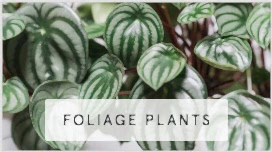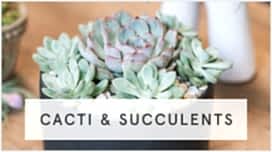5 Things to Keep in Mind Before Buying Houseplants

5 Things to Keep in Mind Before Buying Houseplants
Houseplants offer innumerable benefits. They’re renowned for their natural beauty. They’re championed for their ability to purify the air and rid the home of common airborne contaminants, like xylene and formaldehyde. They’re available in sizes big and small, huge and compact, grand and demure. They add depth and add a hint of zest and personality to any space. They can make even drab rooms look dramatic. It’s no wonder people love them so much.
But it’s not always enough to simply walk into the plant store and grab the first pretty piece that you see. There’s a deeper thought process involved, and taking the time to select the right plant can pay off in many ways. The first step: do some research so you know what’s out there. All houseplants have different needs. Maybe you’re inspired by something you saw on social media, or something caught your eye on a design blog.
Then think about how great it will be to actually become a houseplant owner. Anyone can invite a plant into their home and welcome a touch of the great outdoors inside. If you lack confidence in your abilities or feel like you just aren’t a “plant person,” start combatting those thought processes with a fresher outlook. Anyone can be a plant person, and all it takes is a little bit of effort on your part — sometimes very little at all. Finally, start thinking of yourself as a true plant connoisseur. Selecting the right one is something of a fine art. Here are a few points to consider before you purchase your plant.
1. Light Conditions
You may have a specific type of houseplant in mind — without the sufficient lighting conditions available to support its growth and longevity. This is why it’s essential to prioritize this factor before anything else. A large picture window that invites plenty of natural light into the room is an ideal space to keep a houseplant that demands direct illumination to thrive. Since many common houseplants require continuous light on a daily basis, you need to be certain that your home offers optimal conditions. Cacti, jade plants, sago palms, and crotons are just a few such examples. Without constant attention from the sun, plants will wilt and eventually fade.
There are many plants that do not require so much sunlight, however. In a home where lighting isn’t minimal and there aren’t many windows, consider a pothos plant. Its brilliant leaves add some freshness, color, and jubilance to the space, and it performs beautifully in most environments. Dracaena also handles low-light conditions well. They’re deep and showy, and they tend to grow quite robustly even when lighting is relatively dim. The peace lily is another option known for its ability to thrive in areas where sunlight isn’t persistent. In fact, peace lilies may even bloom and show off their beautiful flowers without a hint of light in the room!
2. Time Commitments
How much time are you willing to devote to your newfound houseplants? This matters for so many reasons. Plants are living things, and they require care, attention, time, and a certain degree of consistency and dedication. Without those things, they cannot be expected to survive for long. For those who work long hours and have busy lifestyles, it may be difficult to tend to a higher-maintenance houseplant that begs for your energy and devotion. Boston ferns and Calatheas are two such examples. They add incredible beauty to the space but must be properly kept to actually live up to their potential.
By contrast, low-maintenance houseplants provide even those with no gardening experience an opportunity to develop an indoor jungle if they desire. The beauty of those plants is that they’re easy to set and forget. More than just simple to care for, they also have the potential to last year-round. This is beneficial because winter, with its dark skies and cold temperatures, can have a negative effect on some people. Adding a vibrant houseplant or two that actually survives the season can instantly boost spirits and lift moods. Among the most indestructible is the trendy ZZ plant. Championed for its rubbery leaves, it handles low-light conditions like a champion and requires little care. You can leave it be for months and it will continue to look fresh. Another option is the humble snake plant. Lack of moisture and minimal lighting won’t affect its condition, and its striking blade leaves add a little visual intrigue to any room.
3. Available Space
Some houseplants are destined to a life of solitude on the desk or the coffee table. The good news is that they play a big role on those surfaces, providing a sense of calm and adding a bit of eye-catching style to otherwise simple spaces. They may also be the only options in rooms where space is limited. You can’t force houseplants — they can appear crowded and overwhelming in areas where they don’t fit properly. This can have precisely the opposite of the intended effect, and may only contribute to stress as you attempt to find a suitable location.
Take an honest look at your surroundings before you commit to any specific houseplant. Is there room in a corner to position a plant that has the potential to grow tall? Could you sacrifice a piece of décor in favor of some natural plant life if you have a particular variety in mind? If tables and desks are your only option, you’ll need to be mindful of the furniture’s original use. If it sits in front of the television, avoid selecting anything that would distract from the view. If it’s a desk, make sure that the plant is sized just right to add a little color and character to the space without overwhelming the work zone. If there’s enough room to mix and match varieties, you might want to step outside of your comfort zone and invite a few different contenders into the space. This offers a coveted jungle effect that so many with green thumbs strive to achieve. You can bring any room to life with a houseplant, be it one or a dozen.
4. Specific Needs
Think about your intentions for purchasing houseplants. If you’re hoping to introduce something specific to your home, then you’ll likely have your eye on a very particular type of plant. A succulent, for example, channels the beauty of the desert. If your home is filled with Southwestern-inspired motifs, then a cactus is a suitable choice that complements the look beautifully. If you have a room that lacks color and personality, you need a plant that actually dresses it up instead of one that simply blends into the space.
But people also purchase houseplants for more practical purposes. A NASA study conducted in 1989 found that plants can purify the air by removing common household contaminants. Some perform this task more efficiently than others, such as snake plants, English ivy, spider plants, Chinese evergreens, orchids, and weeping figs. Those who suffer from allergies may find it necessary to brighten their home with plants in an effort to combat pollutants in the air and establish a cleaner, more comfortable living space.
5. Lifestyle Factors
Lifestyle plays a significant role in determining the most appropriate plants for the home, too. There are many factors that can affect a plant’s longevity, including lack of attention and interference. The former may be an issue for those who spend a considerable amount of time on the road. With limited capacity to care for and tend to houseplants, it can be difficult to cultivate a healthy indoor garden. Yet it’s not impossible, provided you select greenery that’s designed to thrive and remain fresh even when you aren’t around to give it the TLC that it needs. Among the most common options are snake plants, pothos plants, aloe, and jade plants. All of these have a reputation for longevity, and the fact that they’re decidedly hard to kill makes them popular choices among people with little gardening experience, too.
Another key point to consider is the makeup of the family. Parents need to be mindful of selecting plants that are not toxic to kids and pets. Both are vulnerable groups that don’t always understand or recognize that it’s not safe to handle a plant. Animals are also likely to nibble on leaves, which can have disastrous consequences if the plant is not pet-friendly. Some of the best options for big families with both children and pets in the home include Boston ferns, spider plants, Haworthia, and Phalaenopsis orchids. If you’re growing herbs in your indoor garden, you have to be careful, too. Some are toxic to pets, but basil is an easy option that’s not only safe for everyone in the family but also low-maintenance. Moreover, it’s fun to grow and use. Placing it in the kitchen is a smart choice for culinary enthusiasts who want to enjoy the gifts of their labor.
Ultimately, the right choice revolves around what works best in your home, how much time you can devote, and the style you love. The advantages of houseplants are countless, and once you make the right decision, you’ll forget what it was like to live without an indoor jungle in your midst.












